Menu
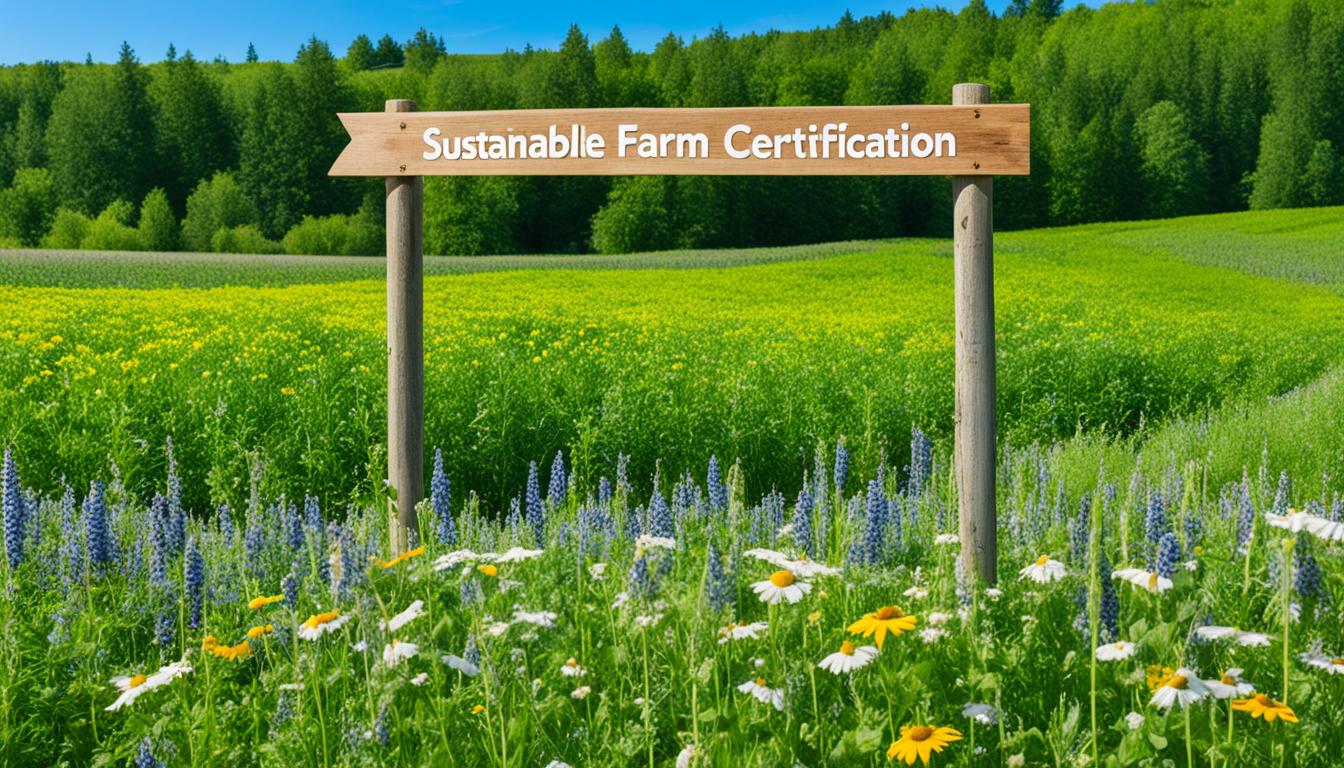
Did you know the global regenerative agricultural market was worth $8.1 billion in 2022? This number is set to more than double to $21.03 billion by 2029. It shows how much people value eco-friendly farming.
This guide will cover the key points of getting a sustainable farm certification. It’s for farmers who want to move from regular farming methods to organic. I’ll talk about the USDA organic standards, different certification rules, and how eco-farming can be both profitable and fulfilling. With my experience as a journalist and an organic farmer in Wisconsin, I want to help on this journey.
Sustainable farm certification aims to encourage farming that’s good for the planet, makes money, and treats people fairly. Getting certified makes sure food production is transparent and trustworthy. We’ll look at what sustainable farm certification means, its importance, and the types available.
To be certified, farms must meet strict rules focusing on being green and lasting. Methods like changing crops each season and using natural ways to control pests are key. They also have to keep detailed records. This guarantees farms work with nature, but also stay profitable and look after their local communities.
Certification is really important for eco-farming for a few reasons. It tells shoppers how and where their food is grown, making them feel good about choosing it. Big names like Clif Bar and Domtar use certifications from the Rainforest Alliance to show they care about the environment. These labels also help farms tell their story and maybe sell products for more money.
There are many types of farm certifications depending on what each focuses on. The USDA organic and Rainforest Alliance labels are well-known. They guarantee food is grown in planet-friendly ways. But they have different rules. The USDA’s is about not using certain chemicals or GMOs. Regenerative agriculture, however, focuses on making the soil healthier and the earth better off. Companies like S&D Coffee, Inc. and Olam International aim for these to support greener farming.
How farms get certified, say by the Rainforest Alliance, changes. The size of the farm and what it grows can affect how much getting certified costs. But there’s help available, like online training, once you start. When farms pass their checks, they earn special labels that make their products more appealing.
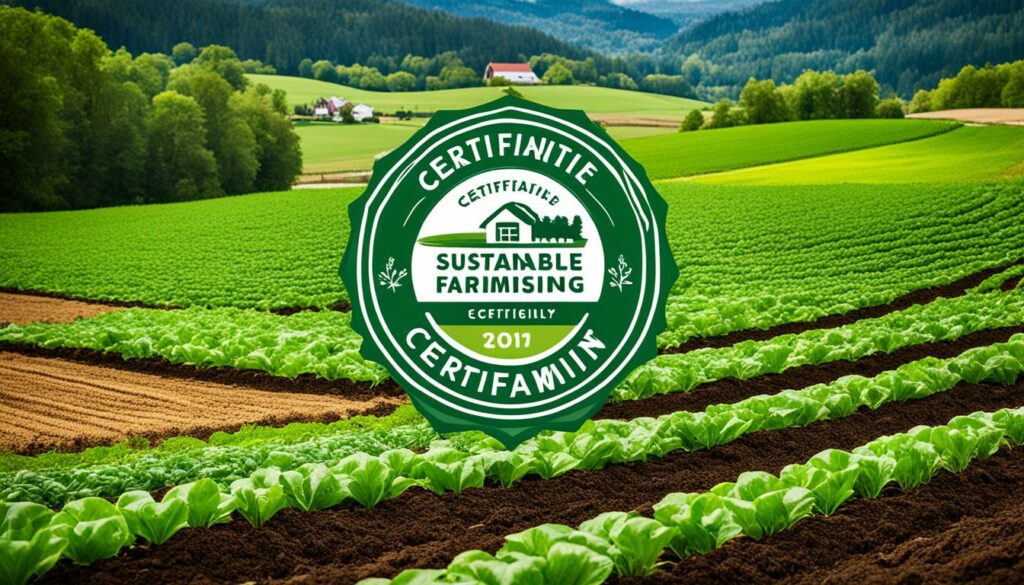
Getting certified for ethical farming or as an organic farm brings many perks. It makes farms stronger in their care for the planet, they earn more money, and help more people.
Farmers with ethical certifications use methods that are good for the land. For example, the Rainforest Alliance encourages practices that help forests and wildlife. These efforts keep invasive species away and reduce conflicts between people and animals. They also make the soil better. By following these strict rules, farms use less water and energy, saving our planet’s resources for the future.
“Partnering with Rainforest Alliance can encourage consumers to buy sustainably produced products, enhancing brand credibility and demonstrating a commitment to environmental preservation.”
Being certified as an organic farm can make products cost more because people trust them more. Farmers find they can make more and spend less thanks to smart farming methods. Having the Rainforest Alliance’s symbol on their products makes people trust them more. This trust can lead to higher pay for farmers and more success in selling their items.
Sustainable certification doesn’t just help the environment and bring in money. It also supports worker rights and well-being. Farms follow strict rules about fair pay and keeping workers safe. They also work to make sure their workers and families have the basics like clean water, healthcare, and education. By choosing these certified products, people can help make communities better.
Starting the journey towards eco-farming certification means you must know what’s required. You will cover all parts of your farm to meet the rules.
The first thing to do in obtaining organic certification is learning about these high standards. The USDA sets these rules. They include keeping records well, managing soil health, and controlling pests properly. Knowing these rules helps you pass the first check and the yearly ones after. The USDA’s Organic Literacy Initiative is a great help. It lets people learn about USDA programs.
Creating an Organic System Plan (OSP) is a key step in the eco-farming certification process. This plan details how you farm. It includes things like what crops you grow, what tools you use, and how you keep pests and diseases away naturally. A good OSP looks at all parts of the farm. It makes sure you are following organic rules. You will also plan to stop using not-allowed substances over three years.
Choosing the right certifying agent is important for your organic system plan development. These agents are approved by the USDA. They might be from a private company, another country or from within your state. They check your farm closely. It’s crucial to pick an agent after looking at where they work, what they offer, and how much they charge. Websites like the National Organic Program and groups like OMRI and WSDA can help you. They ensure you use what’s allowed and follow the best methods. The cost of getting checked can change, based on how big and complex your farm is. Some operations can get help covering up to 75% of this cost from the USDA.
Eco-friendly farming is crucial for the future of our food and protect the planet. One method is using cover crops and green manures. These techniques keep soil healthy. They also stop soil from washing away and hold more water. Cover crops help keep the soil full of nutrients for the next plants.
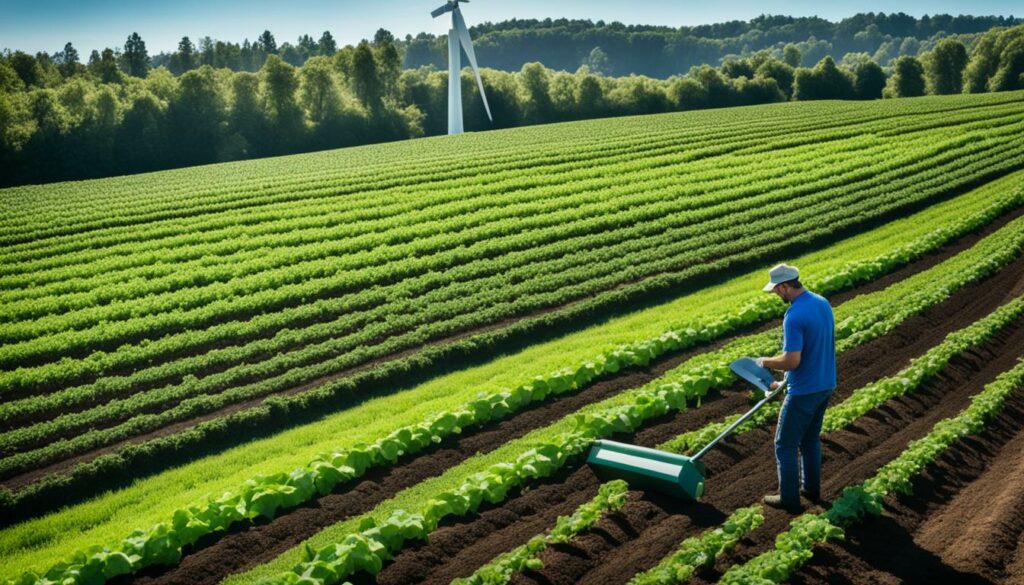
Using integrated pest management (IPM) is key in eco-farming. This limits the need for harmful chemicals. IPM mixes natural and mechanical ways to keep pests under control without hurting the environment.
Conserving water is a big part of sustainable farming. Drip systems and collecting rainwater help save water. This means there’s more water for the future. Farming with trees and shrubs together, called agroforestry, is also beneficial. It helps grow more diverse life, keeps the soil in good shape, and provides shelter for crops.
Working with groups like the Rainforest Alliance and Ecocert is helping to spread sustainable farming. Companies such as Olam International and Clif Bar are leading the charge. The Rainforest Alliance guide helps everyone in farming get more done at less cost.
Ecocert, working in over 130 countries, offers training and certification in sustainable farming. Their work, like with GLOBALG.A.P. and regenerative agriculture, supports many good farming methods. They’ve seen big changes that help 400 farmers earn more and live better.
“For the Sustainable Vanilla Initiative, Ecocert developed a traceability tool impacting 80,000 collectors, 6,000 middlemen, and 100 exporters, ensuring long-term sustainability and improvements in the vanilla supply chain.”
By using eco-farming ways, farmers can live up to green values. These methods protect the earth and keep farming profitable and strong. This is good for us and the planet in the long run.
| Organisation | Role | Benefits |
|---|---|---|
| Rainforest Alliance | Certification and Consulting | Increased productivity, reduced costs, brand credibility |
| Ecocert | Training, Consulting, Certification | Impact assessments, income increase, improved living conditions |
| Olam International | Certified Company | Advocates for sustainable sourcing |
| Clif Bar | Certified Company | Promotes eco-farming methods |
Organic certification sticks to strict USDA rules. These include how to manage soil, what pesticides can be used, and where seeds can come from. It also says no to genetic engineering. Yet, being organically certified doesn’t mean a farm is completely sustainable. Firms may still use a lot of energy for heating and expensive feeds. These can add up and hurt the planet.
Sustainable certifications look beyond this. For example, the NOFA/Mass Sustainability Pledge has wider requirements. It wants farms to be truly healthy. This means no synthetic pesticides, herbicides, or fertilizers used on the land for three years. Also, livestock must eat mostly organic or sustainable food and be raised without harmful chemicals.
The plus points of organic certification include being trusted by buyers and following clear rules. Many people choose organic products. This fact can help farms sell their produce for a better price. But, while this is good, going organic can be hard and expensive for farmers. It often means high costs and using a lot of energy.
Sustainable certification seeks to better the land, using natural ways. It’s about being good for the earth and people. It wants foods to be local and in season. This idea aims to cut down on energy waste and the pollution from shipping food. While these goals are noble, not as many customers may know about or look for sustainable labels. Plus, the rules might not be as strict as those for organic labels.
In the end, understanding these certifications helps farmers decide what’s best for their farm. Both organic and sustainable methods have their advantages and challenges. Yet, the focus should be on caring for the planet. Buying local, organic, and sustainable food is a great way to support this cause.
Keeping soil healthy is key for farming that lasts. Using cover crops and careful nutrient plans can make soil strong and productive. This is good for farmers in the long run.
Cover crops and green manures do a lot for soil. They make it richer, stop weeds, and improve its shape. Adding these plants to crop rotations really helps soil stay healthy.
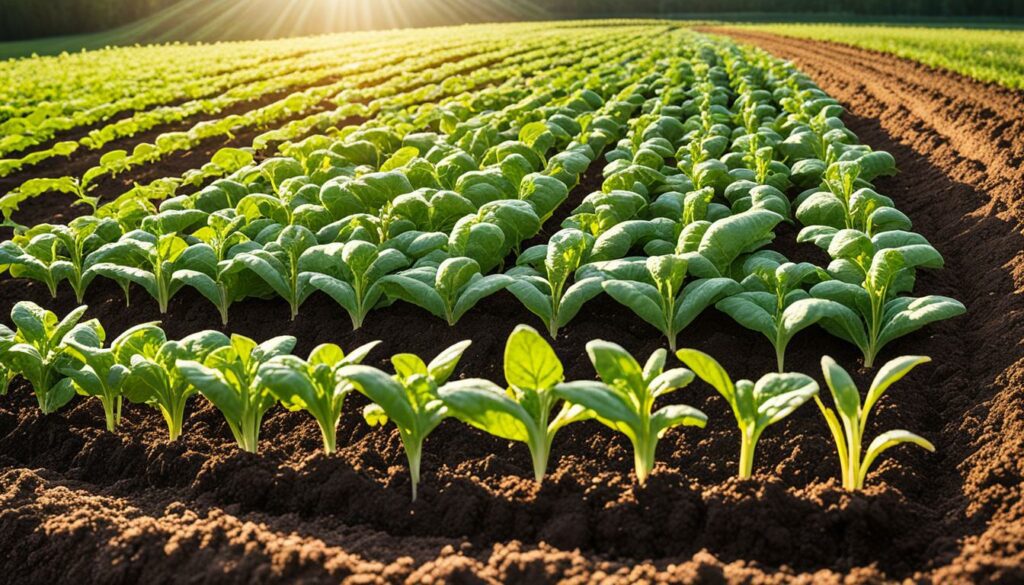
Testing soil often is very important. It helps spot when the soil needs more of certain nutrients. This way, the right changes can be made to keep plants healthy.
Regenerative Organic Certifications are all about making soil richer and locking up carbon, which is good for the earth. This system has different levels and farmers work to improve every year. Regular checks make sure they keep up the good work.
Qualified experts help farmers make plans to get better over time. These plans focus on improving the soil in measurable ways. They need to meet organic standards and include extra good farming practices.
Here’s a quick look at what’s key for soil health:
| Key Practice | Benefits | Implementation |
|---|---|---|
| Cover Crops | Enhances soil fertility and structure, suppresses weeds | Incorporate into crop rotation plans |
| Soil Testing | Identifies nutrient deficiencies, ensures optimal nutrient levels | Conduct tests regularly, adjust fertilisation as needed |
| Nutrient Management | Maintains soil health, promotes growth | Follow testing results, apply precise amendments |
| Regenerative Practices | Increases soil organic matter, sequesters carbon | Adopt practices progressively from Bronze to Gold levels |
Farmers serious about their soil use the best practices. They also follow important certifications like Regenerative Organic. This helps their farms last and be good for the planet.
Good pest and weed control in sustainable farming means using many methods. We try to use fewer man-made chemicals. Integrated Pest Management (IPM) uses a mix of natural and chemical ways to control pests. This helps protect our health, money, and planet.
Farmers often rotate their crops to fight off pests and weeds. By changing what they plant in each field, they make it hard for pests to get a strong hold. This also helps cut down the need for harmful sprays. Using plants that naturally fight pests is also key. These plants need less chemical help to grow well.
When it comes to weeds, growing cover crops like rye is a smart move. These plants help stop weeds from taking over. They also make the soil better and keep it from washing away. Mixing in trees with crops, known as agroforestry, boosts plant and animal variety. It also creates a place where pests don’t thrive.
Courses on pest control and sustainable farming, like SAG 255 and SAG 245, teach a lot. They help students learn how to manage pests and weeds with the planet in mind. Classes such as SAG 272 and SAG 276 give students hands-on practice in farms. They learn how to really use what they’ve learned.
Very important things and how they help:
| Practice | Purpose | Benefits |
|---|---|---|
| Integrated Pest Management (IPM) | Uses many ways to control pests | Makes pest control safer and greener |
| Crop Rotation | Changes crops to stop pests and weeds | Prevents pests and weeds from taking over |
| Cover Crops | Uses plants like rye to fight off weeds | Makes soil better and stops it from washing away |
| Agroforestry | Plants trees with crops to boost variety | Makes a place where less pests live |
Moving animals from one part of the field to another helps the land a lot. This lets them eat fresh, healthy grass and not just the same food over again. It also stops the land from getting too dirty. Ways to keep the soil where it should be, like planting in rows or not tilling so much, are crucial. They stop the soil from going away with the wind or rain. All these methods show how everything in farming is connected. They make sure we can keep farming without hurting the Earth.
Courses on pest control and farming prepare people well. They learn how to take care of their land and crops without causing harm.
Managing livestock for a sustainable farm involves strict rules. This includes caring for the animals well and looking after the environment. It’s important for the animals’ welfare and the farm’s future.
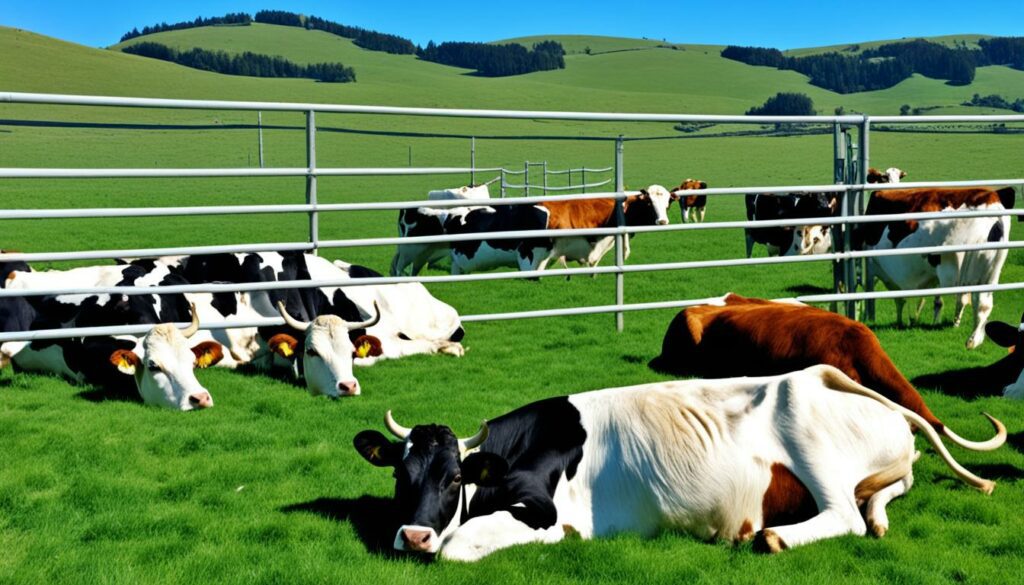
Feeding animals the right way is key to sustainable farming. Livestock must eat from a pasture in the growing season. This makes their diets better, leading to healthier meat and dairy products. By feeding them this way, their food gets richer in good fats and nutrients. The farmers can’t use antibiotics, hormones, or certain pesticides. This keeps the animals and their products clean and safe for us.
Livestock also needs time outdoors. They can’t be kept inside for too long. This rule gives them space and freedom for their natural habits. It also helps the farm save natural resources and support a variety of life. Keeping animals outdoors and allowing them to move between areas is great for the earth too. It helps the soil stay healthy and the farm capture harmful carbon, helping the planet.
Keeping farm animals healthy means using smart health methods. Preventing sickness is the main goal. Farmers do this by giving the animals good living spaces, the right food, and keeping them clean. If an animal does get sick, they use natural, USDA-approved treatments. This way, the farm can avoid adding to the problem of antibiotic-fighting diseases. It’s a win for the animals and for lasting farm health.
| Criteria | Organic Standards | Benefits |
|---|---|---|
| Feed & Nutrition | Organic, pasture during growing season, no antibiotics | Enhanced nutritional quality of products |
| Living Conditions | Year-round outdoor access, rotational grazing | Improved animal welfare, better soil health |
| Health Care | Preventive measures, non-synthetic treatments | Reduced antibiotic resistance, healthier livestock |
On the road to organic certification, record keeping for farm certification is key. The National Organic Program (NOP) says that organic producers must keep records for five years. This makes sure every farm action is well documented and can be checked closely.
When inspected, documents like seed receipts, soil records, and more are looked at closely. All materials used for crops and livestock, from fertilizers to vaccines, must be recorded carefully. This is needed to meet NOP’s high standards.
The NOP wants records systems to be clear enough for anyone to understand. They should show everything about the farm’s work, including compost and disinfection logs. This helps stop any contamination risks.
Good documentation in organic certification doesn’t just mean following rules. It also helps you run your farm better. Here’s how to keep your records neat:
Well-kept records help meet rules and make your farm better. They can be on paper or online, but they must be detailed and easy to check. Keeping these records right is vital for your certification.
Below, find key records for record keeping for farm certification and what should be noted:
| Record Type | Details Required |
|---|---|
| Seeds and Planting Stock | Supplier information, labels, purchase receipts, non-GMO status verification |
| Fertilisers and Soil Amendments | Purchase receipts, application records, test results |
| Pesticides and Pest Control | Purchase receipts, application records, compliance documents |
| Livestock Production | Feed receipts, veterinary treatment records, health logs |
| Harvest Records | Harvest date, lot number, crop/variety, quantity harvested |
| Post-Harvest Activities | Equipment used, clean-out schedules, storage conditions |
Truly good record-keeping isn’t just about rules. It’s a basic part of making your farm work well and last long.
Many farmers need help to make their farms more sustainable. They can get financial aid from programmes. These include the Environmental Quality Incentives Program (EQIP) and the National Resources Conservation Service (NRCS). Both offer money and knowledge to improve farms’ eco-friendliness.
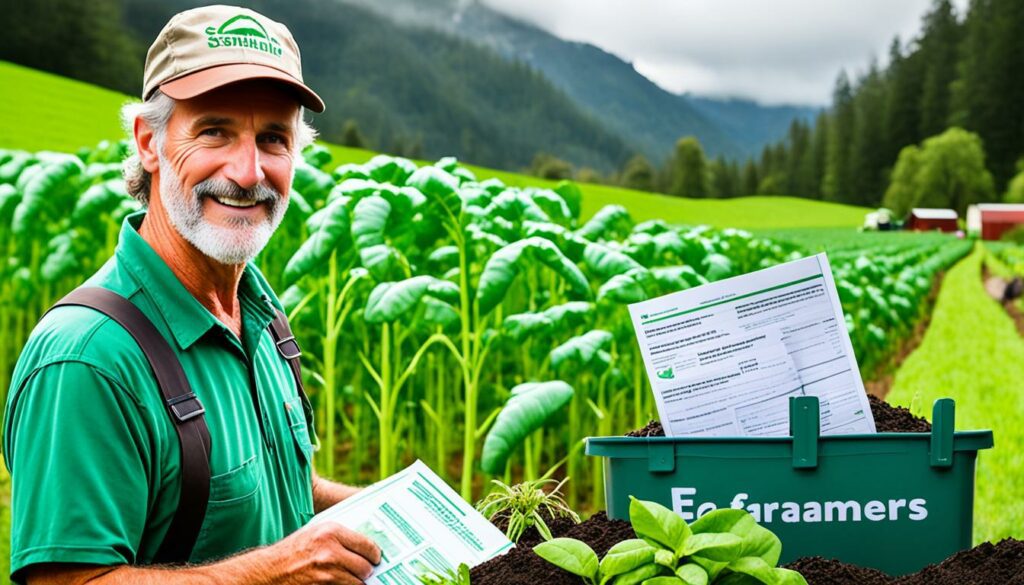
The EQIP programme assists farmers with eco-goals. It provides funds for improving water and soil quality. It helps reduce soil erosion and create homes for wildlife. Applying for EQIP help is straightforward. This ensures farmers can quickly get the support they need. The programme supports many actions. This includes making farming more water-wise and enhancing natural areas.
The NRCS is big on helping farmers keep their land healthy. They offer plans for using the land wisely. These plans follow green and organic rules. They help with keeping soil, water, and plant life in good shape. The NRCS also assists organic farmers with loans and advice on the best ways to farm.
Here’s a table showing main USDA aid for going green in farming:
| Programme | Assistance Type | Coverage |
|---|---|---|
| Organic Certification Cost-Share | Reimbursement | Up to 75%, max $750/year |
| Microloan Program | Financial Assistance | Machinery, equipment, seed, land, water conservation |
| Farm Storage Facility Loan | Low-interest Financing | Storage and handling equipment |
| EQIP | Financial and Technical Assistance | Conservation Practices |
| Conservation Stewardship Program | Performance-based Payments | Improved Conservation Systems |
| Agricultural Management Assistance (AMA) | Risk Management | Natural Resource Issues |
| Value-Added Producer Grants | Funding | Processing Raw Products |
| Farmers Market and Local Food Promotion | Grant | Sustainable Agricultural Projects |
Switching to eco-farming is a big step that takes time and effort. Farmers moving towards sustainable practices have many things to do. They need to stop using certain things and start farming organically. This change might take about three years to complete.
Knowing about financial help is key to a successful switch. The USDA AMS gave nearly $25 million to help with this change. There’s also a big fund to help more, with $10 million extra available.
The USDA NRCS and Oregon Tilth are also helping, providing funds in 2023 to many states. The FSA can cover most of the bill for becoming certified organic. But, you must apply by October 31, 2024, for costs between October 2023 and September 2024.
By using these supports, farmers can lower their transition costs. Becoming a certified sustainable farm can be tough but it’s worthwhile. People are willing to pay more for organic goods. This demand is good news for those who produce certified organic food.
When making the switch, farmers need to keep good records. They must also create a detailed Organic System Plan. This plan is crucial for both rules compliance and for running a sustainable farm well.
| Program | Funding Amount | Purpose |
|---|---|---|
| Organic Market Development Grant (OMDG) | $24.8 million | Support organic market projects |
| NRCS Assistance | $12 million | Help transitioning producers in 22 states |
| OCCSP (by FSA) | Up to 75% of costs, max $750 | Cover organic certification expenses |
Lastly, connecting with certifying bodies and support schemes is vital. Working with groups like Oregon Tilth and the Organic Farming Research Foundation can offer great help. They will get $5 million for organic knowledge and training.
Getting a sustainable farm certification is tough. Farmers face several obstacles. The biggest one is the cost which can be from a few hundred to many thousand dollars each year. There’s also the need for special equipment like no-till planters and precision seeders. Plus, keeping up with standards is complex for many.
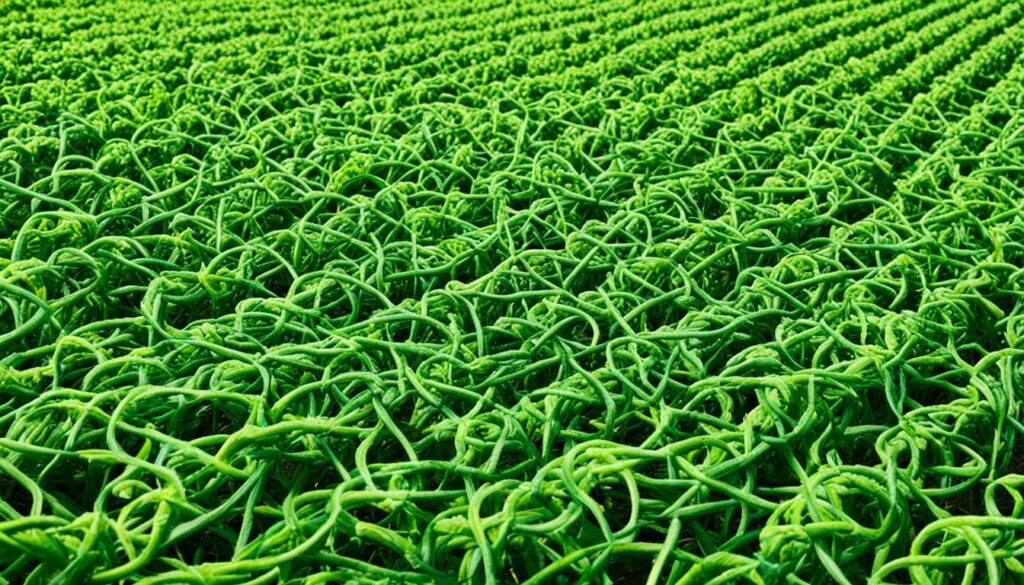
Sustainable farming costs a lot. For instance, organic fertilisers, including compost, can be costly, ranging from $30 to $100 per ton. And organic herbicides are even pricier, costing $100 to $200 per gallon. This is a big challenge, especially for BIPOC farmers.
The shift to sustainable methods can be hard, and without help, some farms may not make it. Yet, there are ways to lower costs like using cover crops. Also, support from programs such as the USDA’s EQIP and NRCS can make a big difference.
Learning from other farmers is key. Between 2007 and 2017, the U.S. lost about 7% of its farms. This shows the need for smart strategies.
Experienced farmers stress the value of mentorship. They say connections with other farmers are crucial. Many find advice from organic and non-organic farmers very helpful.
The wisdom shared in farming communities can guide new farmers. It teaches them to use a step-by-step approach. Strategic planning and seeking continuous advice are essential. They help in meeting certification challenges and building a sustainable future.
The sustainable farm certification is making big changes in farming. Big stores like Costco, Walmart, Aldi, and Lidl give it credit. Companies like Unilever and IDH also back it, showing its high standards and wide use. This helps farmers get more trust and be seen better in markets.
Getting certified is hard work. It starts with looking at your own farm. Then, experts come to check everything. After this, farmers must fix any problems found. Doing things like taking care of the soil and water and using energy better helps farms in many ways. It can make things work smoother, cost less, and be safer. Using digital tools to improve farms is also encouraged.
The future of eco-farming is bright. New tech and rules are helping the earth more. Many shoppers like to buy from farms that are kind to the planet. Having other certifications, like Organic and Fairtrade, can open big markets. This way, farmers can sell more and at a better price. Keeping on the path of sustainable farming will not only keep our planet healthy but also benefit people and improve farm life all over the world.
It’s a way to ensure farms are good for the planet, money-wise, and fair to everyone. It makes farm products more trustworthy and valuable.
Certification is key in eco-farming. It makes sure farming is honest and good for the future, helping shoppers pick the right products. For farmers, it means they can charge more and make their goods stand out.
There are many types, from USDA organic to regenerative farming. They all focus on being green but may have different rules than standard organic.
Certified farms are good for nature, boosting wildlife and keeping our planet healthy. They use clever farming methods like rotating crops and looking after the soil.
Certified farms can make more money. People are willing to pay extra for their produce because it’s green and good for the earth.
Certified farms are safe for workers and help their local community. By buying their products, shoppers support a greener world.
To learn, check out rules on farming, soil, and keeping bugs away. Websites like the National Organic Program are great for info.
This plan shows how farmers will grow things without harming the earth. It’s a must-have for being certified as organic.
Find out about different agents, what they do, and how much they cost. Make sure they’re good as per OMRI and WSDA.
These practices are all about farming without hurting the planet. They include things like using less water, not using chemicals, and welcoming all types of life.
Both are green but organic farming has very specific rules. Sustainable farming follows a wider set of eco-friendly practices.
Cover crops and green manures keep the soil rich and healthy. They also stop weeds and hold on to water, which is good for the earth.
Testing the soil helps know what it needs to stay healthy. You should keep notes on what you feed the soil. This is important for being eco-friendly.
To keep pests and weeds away, it’s best to rotate crops and pick plants that fight off bugs. Using eco-friendly products and keeping a balanced garden also helps.
Livestock need to eat organic food and be able to walk around outside in good weather. They shouldn’t have medicines, growth hormones, or chemicals.
Give animals enough room, a comfy shelter, and fresh air. Use natural ways to keep them healthy. This is all part of being a green farmer.
Keep track of everything you do on the farm, from buying stuff to growing crops. Having clear records shows you’re following the rules.
Find a system for keeping farm records, either on a computer or in a book. The key is to keep everything up to date and in order.
This program helps by giving money and advice. It’s all about keeping water and land clean and safe for animals.
The NRCS helps farmers plan how to take good care of the land and water. They offer step-by-step tips and resources for being eco-friendly.
Changing means stopping harmful things and starting to be organic. Keep good records, make a farm plan, and work with people who check farms for up to three years.
Getting certified can be expensive and hard to understand. To overcome this, get advice, use the available help, and plan well.
Experienced farmers have a lot to share. They offer great tips and encouragement for those aiming to be certified green farmers.